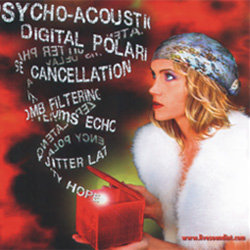Latency is delay that occurs in audio systems due to the time it takes for sound to travel from place to place, and/or due to the time it takes for digital components to perform calculations. However, anecdotal effects of latency sometimes reach almost mystical proportions.
We’ve been told about a certain “psycho-acoustic” phenomenon that causes singers to become disoriented, even with extremely small amounts of latency. Then there was a tale of a drummer that was being “driven crazy” because 4 milliseconds (ms) of latency in his monitor made it sound like the drums were bouncing off the back wall of the room. He just couldn’t deal with the echo.
Some folks have also expressed concern with “comb filtering” with in-ear monitoring (IEM) systems, where the sound conducted through the head gets mixed with delayed monitor sound, thus causing extreme frequency dropouts – so bad as to make it “a severe issue” and “unusable.”
Some of this sounds plausible, some of it sounds a little far-fetched. Just about everyone agrees that latency is bad, but if you must have it, less is always better. Right?
In light of all of these questions and discussions, I decided it was time to learn more about the effects of latency as it pertains to digital audio, digital snakes, live audio and monitors – in particular, in-ear monitors. Unfortunately, I found that there’s very little data published about it.
So, after some research of my own, and numerous conversations with audio professionals and manufacturers, I’ve formed my own take on the subject. What follows is an attempt to remove some of the mystery and present a rational look at latency, it’s real effects, and how much can be tolerated by performers and audiences.
Latency issues have been around forever. Any time audio is reproduced with a microphone and a loudspeaker, there will be delay. Some delay occurs because of the distances that sound travels to microphones and from loudspeakers, as well as from reflections off walls and ceilings.
When digital components are used in a sound system, additional delay is added due to the conversion of analog audio to digital, then transporting that digital data over a network, and then the conversion back to analog. Further, digital effects processing can add even more delay due to the time it takes to perform the digital calculations.
Sound is not faster than a speeding bullet. In fact, sound is relatively slow compared to bullets, fighter jets and space shuttles, traveling in dry air at 32 degrees Fahrenheit at a rate of about 742 miles per hour, or 1087 feet per second (ft/sec).1 For easy figuring, let’s call it 1000 ft/sec, so that sound in air is always delayed from the source to our ears by approximately 1 millisecond per foot (1ms/ft).
Now, give this a try. Plug a microphone into a standard analog sound system and speak while standing 5 feet from the loudspeaker. You’re now experiencing about 5 ms of latency. Step back another 5 feet, and you’re experiencing about 10 ms of latency. Move the microphone a foot away from your mouth, and it adds another 1 ms.
Delays within an ensemble of musicians can be, and often are, relatively long. Think of a symphony where performers are located across a 40-foot stage. The conductor waves a baton to keep time. The percussion section might be 30 feet (and 30 ms) away, while the second violins are 5 feet (and 5 ms) away.
Does the conductor hear all of the notes attacking at different times? The harps might be 40 feet (and 40 ms) away from the timpani. Do they think they sound out of time with each other? How do the musicians stay in synch with each other?
Actually, research sponsored by the National Science Foundation, through the Stanford University Department of Music, has shown that performers in an ensemble have no problem synchronizing with each other while experiencing latencies as high as 40 ms and even greater. In fact, latencies in the 10 ms to 20 ms range actually have a stabilizing affect on tempo and are thought to be preferred over zero latency.2
The one thing for sure is that you can’t make latency go away – it just has to be dealt with.















